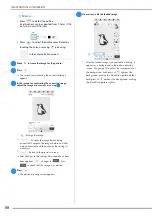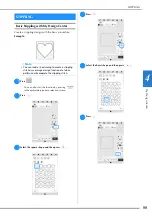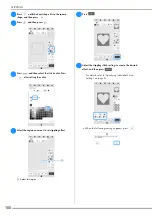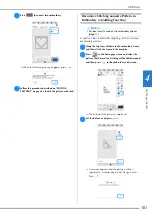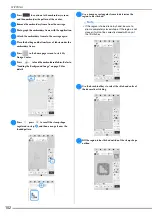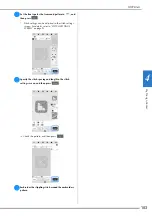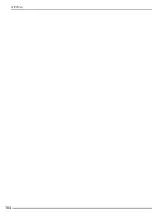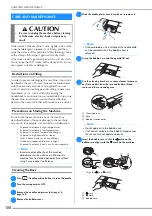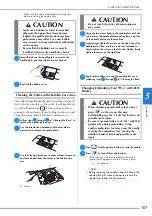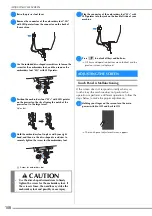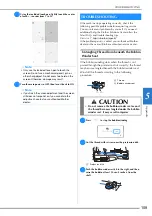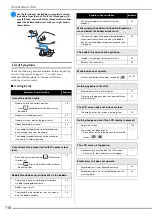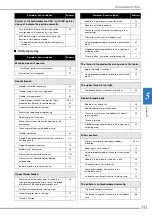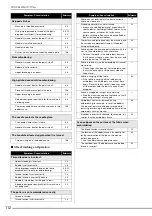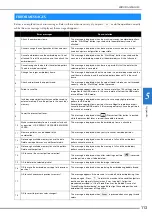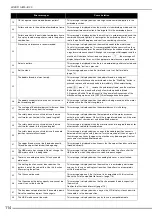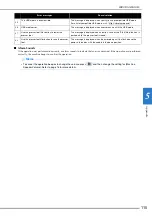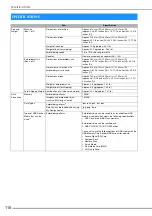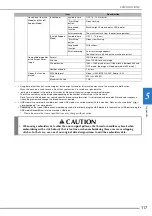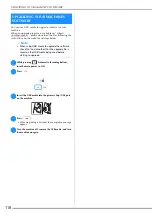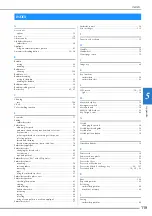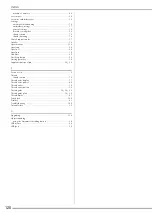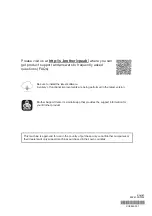
TROUBLESHOOTING
112
■
After Finishing an Operation
Skipped stitches
Machine is threaded incorrectly.
28
Using improper needle, thread or the fabric
prepared insufficiently for embroidering.
30, 55,
62
Needle is turned, bent or the point is dull.
30
Needle is installed incorrectly.
30
Needle is defective.
30
Dust or lint has collected under the needle plate.
106
Not embroidering
Needle is turned, bent or the point is dull.
30
Bobbin is set incorrectly.
26
Upper threading is incorrect.
28
High-pitched sound while embroidering
Needle is turned, bent or the point is dull.
30
Pieces of thread are caught in the race.
106
Upper threading is incorrect.
28
A bobbin designed specifically for this machine is
not being used.
23
There are needle holes or friction scratches in the
bobbin case.
106
The needle contacts the needle plate.
The needle clamp screw is loose.
30
Needle is turned, bent or the point is dull.
30
The handwheel feels sluggish when it is turned.
Thread is tangled in the bobbin case.
106
Symptom, Cause/solution
Reference
Thread tension is incorrect.
Upper threading is incorrect.
28
Bobbin is set incorrectly.
26
Using improper needle, thread or the fabric
prepared insufficiently for embroidering.
30, 55,
62
Thread tension is set incorrectly.
73
Bobbin thread is incorrectly wound.
23
Needle is turned, bent or the point is dull.
30
A bobbin designed specifically for this machine is
not being used.
23
The pattern is not embroidered correctly.
Thread is twisted.
—
Thread tension is set incorrectly.
73
Symptom, Cause/solution
Reference
Fabric was not inserted into the frame correctly
(fabric was loose, etc.).
56
Stabilizing material was not attached.
• Always use stabilizing material, especially with
stretch fabrics, lightweight fabrics, fabrics with a
coarse weave, or fabrics that often cause
pattern shrinkage. See your authorized Brother
dealer for the proper stabilizer.
55
There was an object placed near the machine, and
the carriage or embroidery frame hit the object
during embroidering.
34
Fabric outside the frame edges interferes with the
arm, so the embroidery unit cannot move.
• Reinsert the fabric in the embroidery frame so
that the excess fabric is away from the arm, and
rotate the pattern 180 degrees.
56
Fabric is too heavy, so the embroidery unit cannot
move freely.
• Place a large thick book or similar object under
the arm head to lightly lift the heavy side and
keep it level.
—
Fabric is hanging off the table.
• If the fabric is hanging off the table during
embroidery, the embroidery unit will not move
freely. Place the fabric so that it does not hang
off the table or hold the fabric to keep it from
dragging.
62
Fabric is snagged or caught on something.
• Stop the machine and place the fabric so that it
does not get caught or snagged.
—
Embroidery frame was removed during
embroidering (for example, to reset the bobbin).
The presser foot was bumped or moved while
removing or attaching the embroidery frame, or the
embroidery unit was moved.
66
Stabilizer is incorrectly attached, for example, it is
smaller than the embroidery frame.
55
Loops appear on the surface of the fabric when
embroidering
The thread tension is incorrectly set.
73
The tension of the upper thread is incorrectly set
for the combination of the fabric, thread and
pattern being used.
• Use the embroidery needle plate cover.
62
The combination of the bobbin case and bobbin
thread is incorrect.
62
Symptom, Cause/solution
Reference
Summary of Contents for 882-W80
Page 2: ......
Page 10: ...CONTENTS 8 ...
Page 34: ...CHANGING THE NEEDLE 32 ...
Page 35: ...Chapter 2 Basic Embroidery ...
Page 70: ...ADJUSTMENTS DURING THE EMBROIDERY PROCESS 68 ...
Page 71: ...Chapter 3 Advanced Embroidery ...
Page 86: ...EMBROIDERY APPLICATIONS 84 ...
Page 87: ...Chapter 4 My Design Center ...
Page 106: ...STIPPLING 104 ...
Page 107: ...Chapter 5 Appendix ...
Page 123: ......

